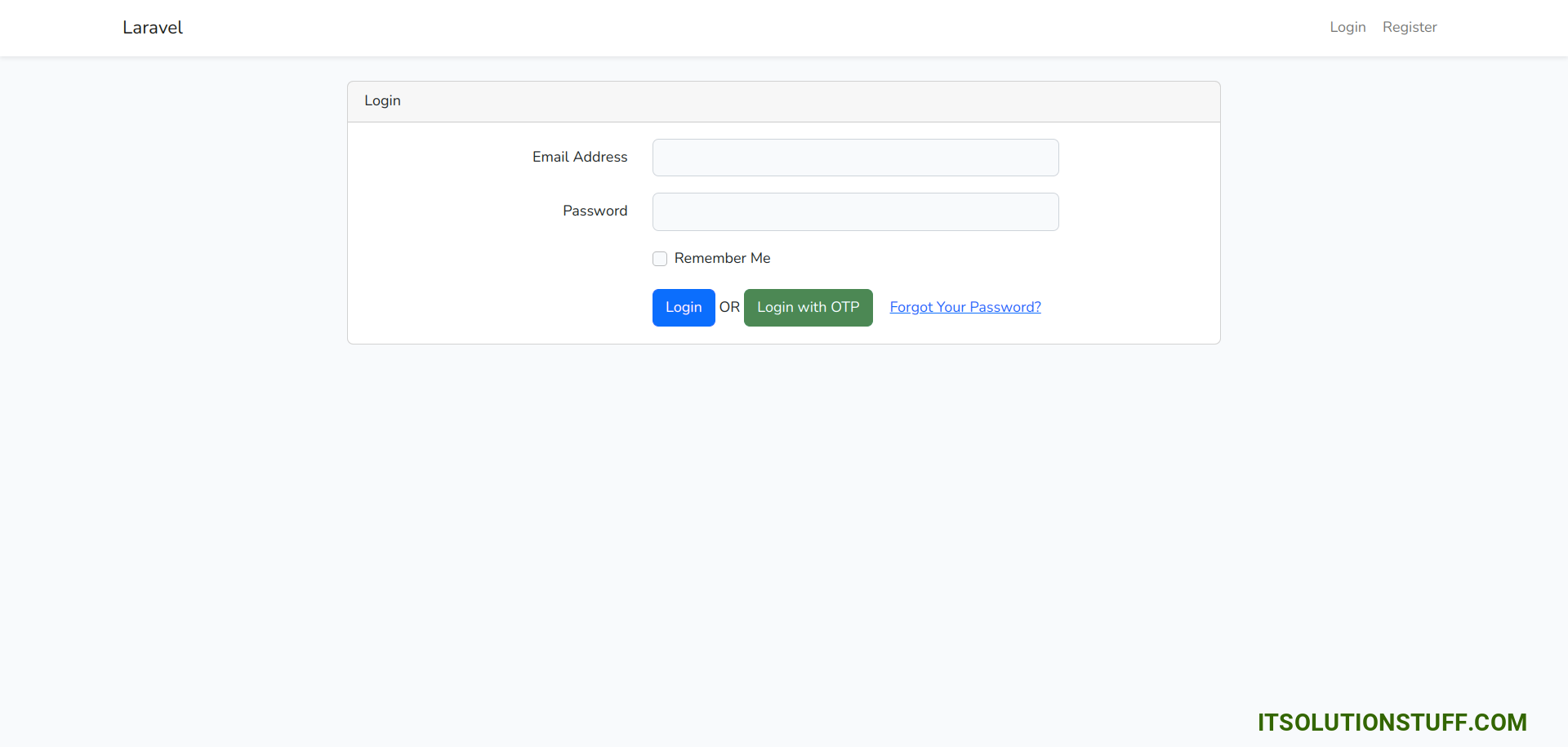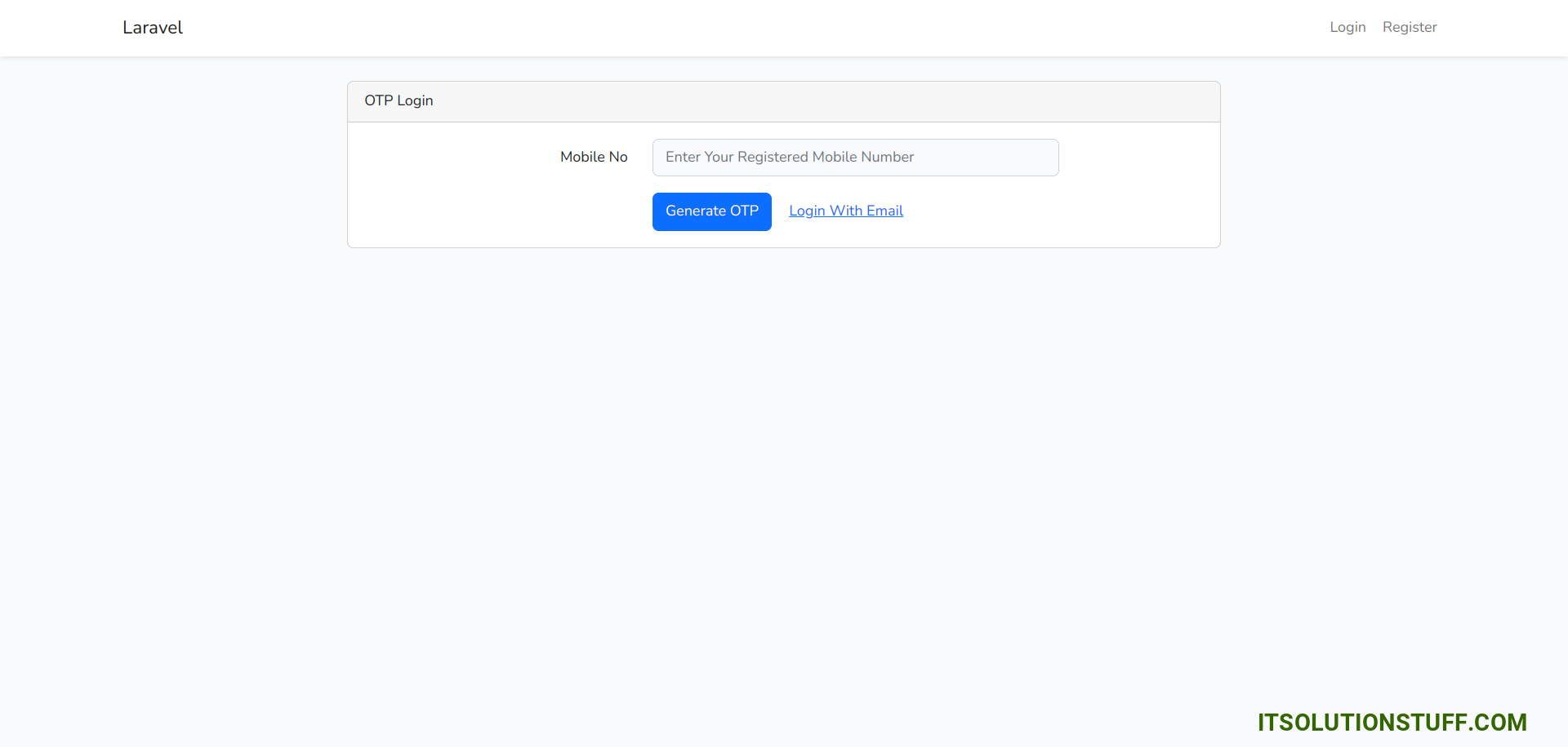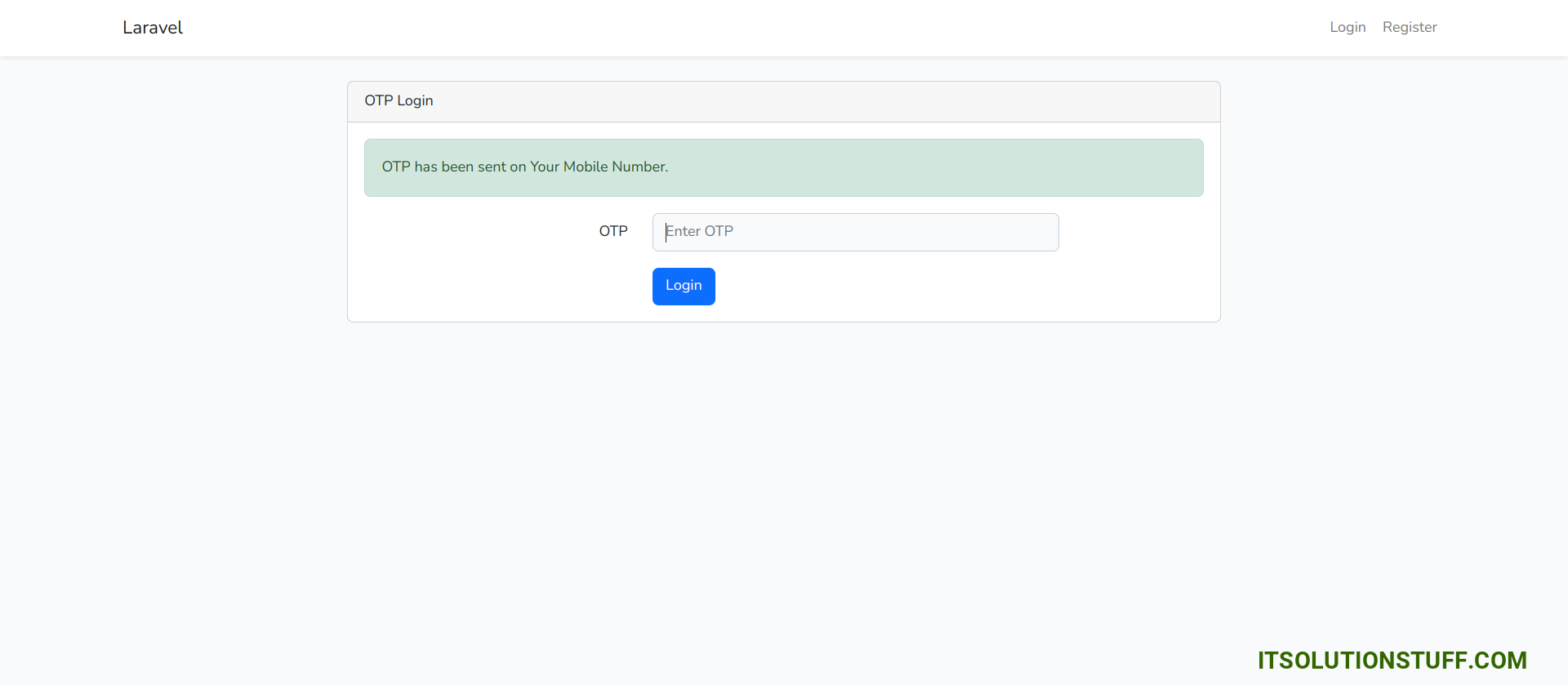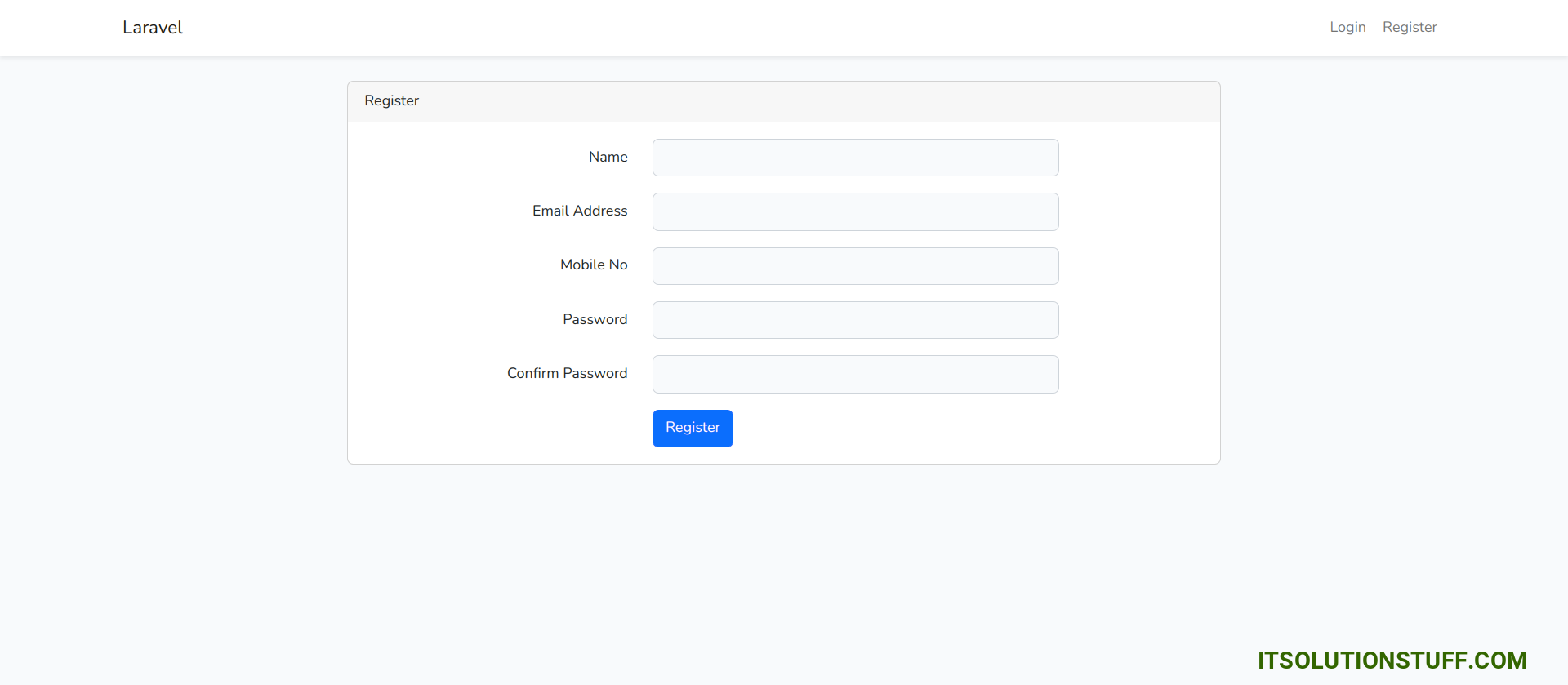Laravel Login with Mobile Number OTP Tutorial
Hello Developer,
In this post, we will learn laravel login with otp. let’s discuss about laravel passport login with otp. This article will give you a simple example of laravel login with mobile number otp. This article goes in detailed on laravel login using otp.
Laravel provides basic authentication using email and passwords. But if you want to add a mobile number OTP-based login then how you will be able to do that?, I will show you how to login with OTP in laravel.
In this example, we will install Laravel UI for basic authentication. When the user will register we will ask for a mobile number. Then we will add a button for login with a mobile number OTP in laravel. When the user enters the mobile number and will receive otp on the mobile number. The user will input OTP and login with that. we will send OTP(One Time Password) in SMS using Twilio API.
So, let's see the following step to do this example. You can login with otp in laravel 6, laravel 7, laravel 8, laravel 9, laravel 10 and laravel 11 versions.
Login Preview:

Mobile Number Preview:

OTP Verify Preview:

Registration Page Preview:

Step for Laravel Authentication OTP with Mobile Phone Tutorial
- Step 1: Install Laravel
- Step 2: Setup Database Configuration
- Step 3: Install Auth Scaffold
- Step 4: Create Migration
- Step 5: Create Model
- Step 6: Create Routes
- Step 7: Create Controller
- Step 8: Create Blade File
- Step 9: Create Twilio Account & Install
- Run Laravel App
Step 1: Install Laravel
This is optional; however, if you have not created the laravel app, then you may go ahead and execute the below command:
composer create-project laravel/laravel example-app
Step 2: Setup Database Configuration
After successfully installing the laravel app then after configuring the database setup. We will open the ".env" file and change the database name, username and password in the env file.
.env
DB_CONNECTION=mysql
DB_HOST=127.0.0.1
DB_PORT=3306
DB_DATABASE=Enter_Your_Database_Name
DB_USERNAME=Enter_Your_Database_Username
DB_PASSWORD=Enter_Your_Database_Password
Step 3: Install Auth Scaffold
Laravel's laravel/ui package provides a quick way to scaffold all of the routes and views you need for authentication using a few simple commands:
composer require laravel/ui
Next, we need to generate auth scaffold with bootstrap, so let's run the below command:
php artisan ui bootstrap --auth
Then, install npm packages using the below command:
npm install
At last, built bootstrap CSS using the below command:
npm run build
Step 4: Create Migration
In this step, we need to create two new migration to add mobile_no field to users table and create new table user_otps. so let's run the below code and run migration.
php artisan make:migration add_new_fields_users
database/migrations/2022_11_24_110854_add_new_fields_users.php
<?php
use Illuminate\Database\Migrations\Migration;
use Illuminate\Database\Schema\Blueprint;
use Illuminate\Support\Facades\Schema;
return new class extends Migration
{
/**
* Run the migrations.
*
* @return void
*/
public function up()
{
Schema::table('users', function (Blueprint $table) {
$table->string('mobile_no')->nullable();
});
}
/**
* Reverse the migrations.
*
* @return void
*/
public function down()
{
Schema::table('users', function (Blueprint $table) {
$table->dropColumn('mobile_no');
});
}
};
php artisan make:migration create_user_otps_table
database/migrations/2022_11_24_110854_create_user_otps_table.php
<?php
use Illuminate\Database\Migrations\Migration;
use Illuminate\Database\Schema\Blueprint;
use Illuminate\Support\Facades\Schema;
return new class extends Migration
{
/**
* Run the migrations.
*
* @return void
*/
public function up()
{
Schema::create('user_otps', function (Blueprint $table) {
$table->id();
$table->bigInteger('user_id');
$table->string('otp');
$table->timestamp('expire_at')->nullable();
$table->timestamps();
});
}
/**
* Reverse the migrations.
*
* @return void
*/
public function down()
{
Schema::dropIfExists('user_otps');
}
};
Now, run migration with following command:
php artisan migrate
Step 5: Create Model
In this step, we will update User.php model and create new model call UserOtp.php. Let's update code for that.
Next, update User.php model file.
app/Models/User.php
<?php
namespace App\Models;
use Illuminate\Database\Eloquent\Factories\HasFactory;
use Illuminate\Foundation\Auth\User as Authenticatable;
use Illuminate\Notifications\Notifiable;
use Laravel\Sanctum\HasApiTokens;
class User extends Authenticatable
{
use HasApiTokens, HasFactory, Notifiable;
/**
* The attributes that are mass assignable.
*
* @var array
*/
protected $fillable = [
'name',
'email',
'password',
'mobile_no'
];
/**
* The attributes that should be hidden for serialization.
*
* @var array
*/
protected $hidden = [
'password',
'remember_token',
];
/**
* The attributes that should be cast.
*
* @var array
*/
protected $casts = [
'email_verified_at' => 'datetime',
];
}
app/Models/UserOtp.php
<?php
namespace App\Models;
use Illuminate\Database\Eloquent\Factories\HasFactory;
use Illuminate\Database\Eloquent\Model;
use Exception;
use Twilio\Rest\Client;
class UserOtp extends Model
{
use HasFactory;
/**
* Write code on Method
*
* @return response()
*/
protected $fillable = ['user_id', 'otp', 'expire_at'];
/**
* Write code on Method
*
* @return response()
*/
public function sendSMS($receiverNumber)
{
$message = "Login OTP is ".$this->otp;
try {
$account_sid = getenv("TWILIO_SID");
$auth_token = getenv("TWILIO_TOKEN");
$twilio_number = getenv("TWILIO_FROM");
$client = new Client($account_sid, $auth_token);
$client->messages->create($receiverNumber, [
'from' => $twilio_number,
'body' => $message]);
info('SMS Sent Successfully.');
} catch (Exception $e) {
info("Error: ". $e->getMessage());
}
}
}
Step 6: Create Routes
In this step, we will create new routes for opt and submit otp code. you can see the below routes:
routes/web.php
<?php
use Illuminate\Support\Facades\Route;
/*
|--------------------------------------------------------------------------
| Web Routes
|--------------------------------------------------------------------------
|
| Here is where you can register web routes for your application. These
| routes are loaded by the RouteServiceProvider within a group which
| contains the "web" middleware group. Now create something great!
|
*/
Route::get('/', function () {
return view('welcome');
});
Auth::routes();
Route::get('/home', [App\Http\Controllers\HomeController::class, 'index'])->name('home');
Route::controller(App\Http\Controllers\Auth\AuthOtpController::class)->group(function(){
Route::get('otp/login', 'login')->name('otp.login');
Route::post('otp/generate', 'generate')->name('otp.generate');
Route::get('otp/verification/{user_id}', 'verification')->name('otp.verification');
Route::post('otp/login', 'loginWithOtp')->name('otp.getlogin');
});
Step 7: Create Controller
Here, we will create AuthOtpController with some methods and update register controller file as well. so let's copy the below code and add to controller file:
app/Http/Controllers/Auth/RegisterController.php
<?php
namespace App\Http\Controllers\Auth;
use App\Http\Controllers\Controller;
use App\Providers\RouteServiceProvider;
use App\Models\User;
use Illuminate\Foundation\Auth\RegistersUsers;
use Illuminate\Support\Facades\Hash;
use Illuminate\Support\Facades\Validator;
class RegisterController extends Controller
{
/*
|--------------------------------------------------------------------------
| Register Controller
|--------------------------------------------------------------------------
|
| This controller handles the registration of new users as well as their
| validation and creation. By default this controller uses a trait to
| provide this functionality without requiring any additional code.
|
*/
use RegistersUsers;
/**
* Where to redirect users after registration.
*
* @var string
*/
protected $redirectTo = RouteServiceProvider::HOME;
/**
* Create a new controller instance.
*
* @return void
*/
public function __construct()
{
$this->middleware('guest');
}
/**
* Get a validator for an incoming registration request.
*
* @param array $data
* @return \Illuminate\Contracts\Validation\Validator
*/
protected function validator(array $data)
{
return Validator::make($data, [
'name' => ['required', 'string', 'max:255'],
'mobile_no' => ['required', 'numeric', 'digits:10'],
'email' => ['required', 'string', 'email', 'max:255', 'unique:users'],
'password' => ['required', 'string', 'min:8', 'confirmed'],
]);
}
/**
* Create a new user instance after a valid registration.
*
* @param array $data
* @return \App\Models\User
*/
protected function create(array $data)
{
return User::create([
'name' => $data['name'],
'mobile_no' => $data['mobile_no'],
'email' => $data['email'],
'password' => Hash::make($data['password']),
]);
}
}
app/Http/Controllers/Auth/AuthOtpController.php
<?php
namespace App\Http\Controllers\Auth;
use App\Http\Controllers\Controller;
use Illuminate\Http\Request;
use Illuminate\Support\Facades\Auth;
use App\Models\User;
use App\Models\UserOtp;
class AuthOtpController extends Controller
{
/**
* Write code on Method
*
* @return response()
*/
public function login()
{
return view('auth.otpLogin');
}
/**
* Write code on Method
*
* @return response()
*/
public function generate(Request $request)
{
/* Validate Data */
$request->validate([
'mobile_no' => 'required|exists:users,mobile_no'
]);
/* Generate An OTP */
$userOtp = $this->generateOtp($request->mobile_no);
$userOtp->sendSMS($request->mobile_no);
return redirect()->route('otp.verification', ['user_id' => $userOtp->user_id])
->with('success', "OTP has been sent on Your Mobile Number.");
}
/**
* Write code on Method
*
* @return response()
*/
public function generateOtp($mobile_no)
{
$user = User::where('mobile_no', $mobile_no)->first();
/* User Does not Have Any Existing OTP */
$userOtp = UserOtp::where('user_id', $user->id)->latest()->first();
$now = now();
if($userOtp && $now->isBefore($userOtp->expire_at)){
return $userOtp;
}
/* Create a New OTP */
return UserOtp::create([
'user_id' => $user->id,
'otp' => rand(123456, 999999),
'expire_at' => $now->addMinutes(10)
]);
}
/**
* Write code on Method
*
* @return response()
*/
public function verification($user_id)
{
return view('auth.otpVerification')->with([
'user_id' => $user_id
]);
}
/**
* Write code on Method
*
* @return response()
*/
public function loginWithOtp(Request $request)
{
/* Validation */
$request->validate([
'user_id' => 'required|exists:users,id',
'otp' => 'required'
]);
/* Validation Logic */
$userOtp = UserOtp::where('user_id', $request->user_id)->where('otp', $request->otp)->first();
$now = now();
if (!$userOtp) {
return redirect()->back()->with('error', 'Your OTP is not correct');
}else if($userOtp && $now->isAfter($userOtp->expire_at)){
return redirect()->route('otp.login')->with('error', 'Your OTP has been expired');
}
$user = User::whereId($request->user_id)->first();
if($user){
$userOtp->update([
'expire_at' => now()
]);
Auth::login($user);
return redirect('/home');
}
return redirect()->route('otp.login')->with('error', 'Your Otp is not correct');
}
}
Step 8: Create Blade File
In this step, we will create new blade file for otpLogin and otpVerification, then we will update login and register page as well. so let's update following file:
resources/views/auth/otpLogin.blade.php
@extends('layouts.app')
@section('content')
<div class="container">
<div class="row justify-content-center">
<div class="col-md-8">
<div class="card">
<div class="card-header">{{ __('OTP Login') }}</div>
<div class="card-body">
@if (session('error'))
<div class="alert alert-danger" role="alert"> {{session('error')}}
</div>
@endif
<form method="POST" action="{{ route('otp.generate') }}">
@csrf
<div class="row mb-3">
<label for="mobile_no" class="col-md-4 col-form-label text-md-end">{{ __('Mobile No') }}</label>
<div class="col-md-6">
<input id="mobile_no" type="text" class="form-control @error('mobile_no') is-invalid @enderror" name="mobile_no" value="{{ old('mobile_no') }}" required autocomplete="mobile_no" autofocus placeholder="Enter Your Registered Mobile Number">
@error('mobile_no')
<span class="invalid-feedback" role="alert">
<strong>{{ $message }}</strong>
</span>
@enderror
</div>
</div>
<div class="row mb-0">
<div class="col-md-8 offset-md-4">
<button type="submit" class="btn btn-primary">
{{ __('Generate OTP') }}
</button>
@if (Route::has('login'))
<a class="btn btn-link" href="{{ route('login') }}">
{{ __('Login With Email') }}
</a>
@endif
</div>
</div>
</form>
</div>
</div>
</div>
</div>
</div>
@endsection
resources/views/auth/otpVerification.blade.php
@extends('layouts.app')
@section('content')
<div class="container">
<div class="row justify-content-center">
<div class="col-md-8">
<div class="card">
<div class="card-header">{{ __('OTP Login') }}</div>
<div class="card-body">
@if (session('success'))
<div class="alert alert-success" role="alert"> {{session('success')}}
</div>
@endif
@if (session('error'))
<div class="alert alert-danger" role="alert"> {{session('error')}}
</div>
@endif
<form method="POST" action="{{ route('otp.getlogin') }}">
@csrf
<input type="hidden" name="user_id" value="{{$user_id}}" />
<div class="row mb-3">
<label for="mobile_no" class="col-md-4 col-form-label text-md-end">{{ __('OTP') }}</label>
<div class="col-md-6">
<input id="otp" type="text" class="form-control @error('otp') is-invalid @enderror" name="otp" value="{{ old('otp') }}" required autocomplete="otp" autofocus placeholder="Enter OTP">
@error('otp')
<span class="invalid-feedback" role="alert">
<strong>{{ $message }}</strong>
</span>
@enderror
</div>
</div>
<div class="row mb-0">
<div class="col-md-8 offset-md-4">
<button type="submit" class="btn btn-primary">
{{ __('Login') }}
</button>
</div>
</div>
</form>
</div>
</div>
</div>
</div>
</div>
@endsection
Now, we need to update login and register view files:
resources/views/auth/login.blade.php
@extends('layouts.app')
@section('content')
<div class="container">
<div class="row justify-content-center">
<div class="col-md-8">
<div class="card">
<div class="card-header">{{ __('Login') }}</div>
<div class="card-body">
<form method="POST" action="{{ route('login') }}">
@csrf
<div class="row mb-3">
<label for="email" class="col-md-4 col-form-label text-md-end">{{ __('Email Address') }}</label>
<div class="col-md-6">
<input id="email" type="email" class="form-control @error('email') is-invalid @enderror" name="email" value="{{ old('email') }}" required autocomplete="email" autofocus>
@error('email')
<span class="invalid-feedback" role="alert">
<strong>{{ $message }}</strong>
</span>
@enderror
</div>
</div>
<div class="row mb-3">
<label for="password" class="col-md-4 col-form-label text-md-end">{{ __('Password') }}</label>
<div class="col-md-6">
<input id="password" type="password" class="form-control @error('password') is-invalid @enderror" name="password" required autocomplete="current-password">
@error('password')
<span class="invalid-feedback" role="alert">
<strong>{{ $message }}</strong>
</span>
@enderror
</div>
</div>
<div class="row mb-3">
<div class="col-md-6 offset-md-4">
<div class="form-check">
<input class="form-check-input" type="checkbox" name="remember" id="remember" {{ old('remember') ? 'checked' : '' }}>
<label class="form-check-label" for="remember">
{{ __('Remember Me') }}
</label>
</div>
</div>
</div>
<div class="row mb-0">
<div class="col-md-8 offset-md-4">
<button type="submit" class="btn btn-primary">
{{ __('Login') }}
</button>
OR
<a class="btn btn-success" href="{{ route('otp.login') }}">
Login with OTP
</a>
@if (Route::has('password.request'))
<a class="btn btn-link" href="{{ route('password.request') }}">
{{ __('Forgot Your Password?') }}
</a>
@endif
</div>
</div>
</form>
</div>
</div>
</div>
</div>
</div>
@endsection
resources/views/auth/register.blade.php
@extends('layouts.app')
@section('content')
<div class="container">
<div class="row justify-content-center">
<div class="col-md-8">
<div class="card">
<div class="card-header">{{ __('Register') }}</div>
<div class="card-body">
<form method="POST" action="{{ route('register') }}">
@csrf
<div class="row mb-3">
<label for="name" class="col-md-4 col-form-label text-md-end">{{ __('Name') }}</label>
<div class="col-md-6">
<input id="name" type="text" class="form-control @error('name') is-invalid @enderror" name="name" value="{{ old('name') }}" required autocomplete="name" autofocus>
@error('name')
<span class="invalid-feedback" role="alert">
<strong>{{ $message }}</strong>
</span>
@enderror
</div>
</div>
<div class="row mb-3">
<label for="email" class="col-md-4 col-form-label text-md-end">{{ __('Email Address') }}</label>
<div class="col-md-6">
<input id="email" type="email" class="form-control @error('email') is-invalid @enderror" name="email" value="{{ old('email') }}" required autocomplete="email">
@error('email')
<span class="invalid-feedback" role="alert">
<strong>{{ $message }}</strong>
</span>
@enderror
</div>
</div>
<div class="row mb-3">
<label for="mobile_no" class="col-md-4 col-form-label text-md-end">{{ __('Mobile No') }}</label>
<div class="col-md-6">
<input id="mobile_no" type="text" class="form-control @error('mobile_no') is-invalid @enderror" name="mobile_no" value="{{ old('mobile_no') }}" required autocomplete="mobile_no" autofocus>
@error('mobile_no')
<span class="invalid-feedback" role="alert">
<strong>{{ $message }}</strong>
</span>
@enderror
</div>
</div>
<div class="row mb-3">
<label for="password" class="col-md-4 col-form-label text-md-end">{{ __('Password') }}</label>
<div class="col-md-6">
<input id="password" type="password" class="form-control @error('password') is-invalid @enderror" name="password" required autocomplete="new-password">
@error('password')
<span class="invalid-feedback" role="alert">
<strong>{{ $message }}</strong>
</span>
@enderror
</div>
</div>
<div class="row mb-3">
<label for="password-confirm" class="col-md-4 col-form-label text-md-end">{{ __('Confirm Password') }}</label>
<div class="col-md-6">
<input id="password-confirm" type="password" class="form-control" name="password_confirmation" required autocomplete="new-password">
</div>
</div>
<div class="row mb-0">
<div class="col-md-6 offset-md-4">
<button type="submit" class="btn btn-primary">
{{ __('Register') }}
</button>
</div>
</div>
</form>
</div>
</div>
</div>
</div>
</div>
@endsection
Step 9: Create Twilio Account & Install
First you need to create and add phone number. then you can easily get account SID, Token and Number.
Create Account from here: www.twilio.com.
Next add Twilio Phone Number
Next you can get account SID, Token and Number and add on .env file as like bellow:
.env
TWILIO_SID=XXXXXXXXXXXXXXXXX
TWILIO_TOKEN=XXXXXXXXXXXXX
TWILIO_FROM=+XXXXXXXXXXX
next, we need to install twilio/sdk composer package to use send SMS using twilio. so let's run bellow command:
composer require twilio/sdk
Run Laravel App:
All the required steps have been done, now you have to type the given below command and hit enter to run the Laravel app:
php artisan serve
Now, Go to your web browser, type the given URL and view the app output:
http://localhost:8000/
You can see all the above screens as output.
I hope it can help you...

